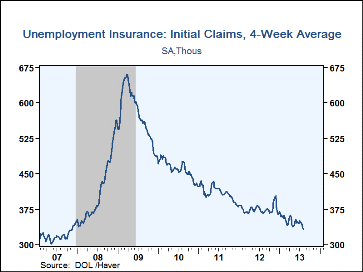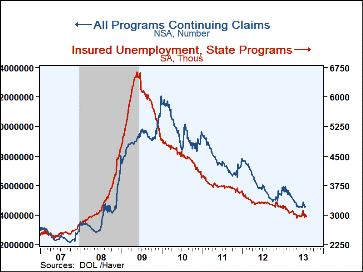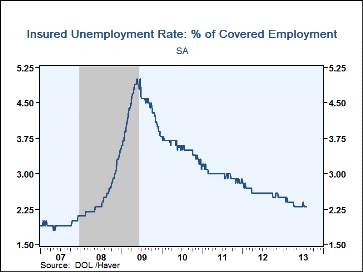 Global| Aug 15 2013
Global| Aug 15 2013U.S. Initial Claims Drop to 320K; Pre-Crisis Lows Sustained
Summary
Initial claims for unemployment insurance dropped to 320,000 (-12.8% y/y) in the August 10 week from 335,000 the week before, which was initially reported as 333,000. This latest figure is the lowest since October 6, 2007. It compares [...]
 Initial claims for unemployment insurance dropped to 320,000 (-12.8% y/y) in the August 10 week from 335,000 the week before, which was initially reported as 333,000. This latest figure is the lowest since October 6, 2007. It compares to an expected unchanged tally of 335,000 in the Action Economics Forecast Survey. The four-week moving average of initial claims fell further to a new cycle low of 332,000. During the last ten years, there has been a 75% negative correlation between the level of claims and the m/m change in nonfarm payrolls.
Initial claims for unemployment insurance dropped to 320,000 (-12.8% y/y) in the August 10 week from 335,000 the week before, which was initially reported as 333,000. This latest figure is the lowest since October 6, 2007. It compares to an expected unchanged tally of 335,000 in the Action Economics Forecast Survey. The four-week moving average of initial claims fell further to a new cycle low of 332,000. During the last ten years, there has been a 75% negative correlation between the level of claims and the m/m change in nonfarm payrolls.
Continuing claims for unemployment insurance in the week ended August 3 fell to 2.969 million (-10.3% y/y) from 3.023 million. The four-week moving average of continuing claims fell to 2.986 million from the prior reading of 3.025 million. The insured rate of unemployment held at 2.3%. This particular count covers only "regular" programs and does not include all extended benefit and other specialized jobless insurance programs. In the week of July 27, the latest of the broader data available, the grand total of all benefit recipients rose to 4.587 million (-19.6% y/y). This broader measure is not seasonally adjusted. It compares to a cycle peak of 12.060 million in January 2010. The number of individuals who were collecting emergency and extended payments rose in the July 27 week to 1.553 million, but was still down 34.6% from a year ago. This item is also not seasonally adjusted.
By state, the largest increases in initial claims for the week ending August 3 were in California (+3,481), Puerto Rico (+3,081), Ohio (+1,483), Tennessee (+1,016) and South Carolina (+693), while the largest decreases were in Illinois (-2,090), Oregon (-2,026), New Jersey (-1,672), Connecticut (-783) and Pennsylvania (-608). These weekly changes are based on Haver Analytics seasonal adjustment of the original Labor Department data.
Data on weekly unemployment insurance are contained in Haver's WEEKLY database and they are summarized monthly in USECON. Data for individual states are in REGIONW. The consensus estimates come from the Action Economics survey, carried in the AS1REPNA database.
| Unemployment Insurance (000s) | 08/10/13 | 08/03/13 | 07/27/13 | Y/Y % | 2012 | 2011 | 2010 |
|---|---|---|---|---|---|---|---|
| Initial Claims | 320 | 335 | 328 | -9.5 | 375 | 409 | 459 |
| Continuing Claims | -- | 2,969 | 3,023 | -9.2 | 3,318 | 3,744 | 4,544 |
| Insured Unemployment Rate (%) | -- | 2.3 | 2.3 | 2.6 (7/12) |
2.6 | 3.0 | 3.6 |
| Total "All Programs" (NSA) | -- | -- | 4.587 mil. | -21.4 | 6.047 mil. | 7.750 mil. | 9.850 mil. |
Carol Stone, CBE
AuthorMore in Author Profile »Carol Stone, CBE came to Haver Analytics in 2003 following more than 35 years as a financial market economist at major Wall Street financial institutions, most especially Merrill Lynch and Nomura Securities. She has broad experience in analysis and forecasting of flow-of-funds accounts, the federal budget and Federal Reserve operations. At Nomura Securites, among other duties, she developed various indicator forecasting tools and edited a daily global publication produced in London and New York for readers in Tokyo. At Haver Analytics, Carol is a member of the Research Department, aiding database managers with research and documentation efforts, as well as posting commentary on select economic reports. In addition, she conducts Ways-of-the-World, a blog on economic issues for an Episcopal-Church-affiliated website, The Geranium Farm. During her career, Carol served as an officer of the Money Marketeers and the Downtown Economists Club. She has a PhD from NYU's Stern School of Business. She lives in Brooklyn, New York, and has a weekend home on Long Island.







